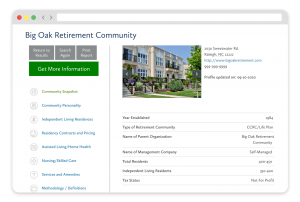When people consider moving into a senior living community, their decision is often influenced by a combination of amenities, healthcare offerings, and cost. But beyond those practical considerations lies something more intangible, yet arguably just as essential: how a retirement community fosters a culture of respectful, compassionate care.
Yes, it’s natural and understandable that prospective residents and their families tend to focus on a community’s services and structures. Yet it’s the day-to-day interpersonal interactions between resident and staff members — the words spoken, the tone used, the respect shown — that may shape senior living residents’ lived experience more profoundly than almost anything else.
The famous quote from Maya Angelou comes to mind: “I’ve learned that people will forget what you said, people will forget what you did, but people will never forget how you made them feel.” That’s why some of the most successful senior living communities prioritize not only quality of care but the dignity, empathy, and emotional connection extended from leadership to staff, and from staff to residents.
A tale of two experiences
This truth was underscored in a recent conversation I had with a woman considering a move into a continuing care retirement community (CCRC, also called a life plan community) in Texas. She shared the experiences of both her own father and her mother-in-law, each of whom had lived in different CCRCs.
Her father, an introverted man by nature, had a truly wonderful CCRC experience. The staff at his community treated him and his fellow residents with authentic kindness and respect … never patronizing, always human. She told me, quite movingly, that her father began to “blossom” during his years there, especially as he transitioned into higher levels of care in the CCRC’s healthcare center, which involved even more frequent interactions with staff. He felt cared for, seen, and valued.
In contrast, her mother-in-law’s CCRC experience was lackluster. When she entered the community’s healthcare center, she was placed in a room with a “view” of a brick wall, and while the staff wasn’t overtly unkind, they weren’t particularly attentive or caring either. The mother-in-law’s days lacked the warmth and connection that had helped this woman’s father thrive in his later years.
>> Related: Evaluating Care, Quality, and Access at a CCRC’s Healthcare Center
How you make people feel: The core of resident satisfaction
What struck me in hearing this woman’s personal story, and what Maya Angelou so beautifully captured in her words, is that how residents feel may be the single most important aspect of the senior living industry. You would think this would be apparent to every retirement community, but sadly, that’s not always the case.
I would contend that, in large part, it is culture that sets great communities apart from the average ones, and a retirement community’s culture begins with its leadership and its staff. How team members talk to residents, how they listen, how they engage with empathy and consistency; these are the moments that shape residents’ experiences in a CCRC or any type of retirement community.
>> Related: The Heart of the Community: How Retirement Community Employees Enrich Residents’ Lives
Leadership, culture, and the employee experience
There’s plenty of research to support this emphasis on retirement communities’ culture. A 2024 report from national senior living association Argentum entitled “Navigating the Nexus: Addressing Workforce Challenges in Senior Living” identifies staff retention as “the cornerstone of continuity, consistency and, above all, quality of care” within a retirement community.
The Argentum report’s authors also contend that addressing the senior living industry’s ongoing workforce challenges is “not merely a matter of operational efficiency. … It is a moral imperative, a testament to our commitment to honor the dignity of the lives of our elders.”
Yet staff turnover continues to plague the senior living and care industry. In fact, a 2021 analysis of data collected from the Centers for Medicare and Medicaid Services shows that the median annual turnover for nursing assistants within the nation’s nursing homes was nearly 99% between 2016 and 2021!
Organizational culture trickles down to the resident
There’s no denying that working in healthcare and long-term care can be stressful, exhausting, and at times, thankless, while also being low paying in many cases. It’s understandable that many employees decide the pros don’t outweigh the cons and thus they leave their job (or abandon the profession entirely), hence the employee retention issues within many senior living communities.
To help quell high staff turnover, retirement communities need to first address their leadership culture, which in turn directly impacts employee retention, satisfaction, and job performance.
Studies on retirement community employee retention consistently show that staff members desire better support from leaders (in addition higher pay, lighter workloads, and better working conditions). They also want improvements in education and training, better career pathways, and more support for their mental and physical wellbeing.
Interestingly, a study published in 2012 in the Journal of Nursing Management found that for many organizations within the senior living and healthcare industries, respect, loyalty, and support from leadership actually had a greater impact on nursing staff retention than compensation or workplace experiences.
In short, research nearly unanimously posits that when retirement communities and other types of healthcare organizations prioritize a positive culture from the top down, it enables them to retain more high caliber staff members, who in turn provide their residents with better overall care.
And what’s more, according to a 2020 case study which assessed and analyzed data from 31 retirement communities in the U.S., communities with a strongly positive organizational culture also have notably higher average occupancy rates (94%), suggesting higher resident satisfaction as well. By contrast, the retirement communities with the least “healthy” organizational culture had an average occupancy rate of just 66%, markedly lower than the national average occupancy rate of 87%.
>> Related: Inflection Point: Our Nation’s Ever-Growing Long-Term Care Crisis
Fostering a positive culture, from top to bottom and inside out
Creating a strong culture of compassion doesn’t happen by accident. It begins with hiring the right people at every level. And we’re not just talking about those with the right qualifications on paper, but those with the right heart and attitude.
A positive culture is sustained through meaningful training that goes beyond standard procedures for both employee management and resident care. It emphasizes listening, patience, human connection, and empathy.
Most importantly, a positive top-to-bottom culture is reinforced every single day: in team meetings, in the way supervisors recognize staff contributions, and in the way feedback from residents is genuinely welcomed and acted upon. Culture can’t be just a plaque on the wall or a values statement on a website; it has to be practiced consistently, all the way from the executive director to the front-line staff member.
Of course, the aforementioned high turnover rates and staffing shortages are persistent issues in senior living and care, but they’re not insurmountable. Retirement communities that invest in their teams through better training, recognition, mental health support, and clear paths to career advancement consistently see better staff retention and stronger resident satisfaction.
>> Related: Developing the Next Generation of Senior Living Leadership
Mutual respect and care in every aspect of senior living culture
As the number of older Americans grows in the coming years and demand for top talent accelerates within the senior living industry, the most respected and thriving retirement communities (and the ones that will likely have the highest quality, occupancy, and satisfaction rates) will be the ones that make culture and employee support strategic priorities.
For older adults who are considering a senior living move, it’s wise to look beyond the retirement community’s brochure. Visit in person and observe the community’s culture in action. Watch how employees interact with residents. Listen for laughter. See if staff remember residents’ names. And notice whether team members seem engaged or preoccupied.
Also be sure to ask questions … and not just about amenities, but about staff training, employee turnover, and the organization’s values. A beautiful building means little if the relationships within it don’t reflect care, compassion, and dignity.
Ultimately, this is what matters most: When we remember the people who made the biggest impact on our lives, we don’t remember what car they drove or what title they held. As Ms. Angelou observed, we remember how they made us feel. The same is true in senior living, both for employees and residents alike.
And for retirement communities looking to truly differentiate themselves, this is an ideal place to begin. Create and foster a culture where residents feel respected, staff feel empowered, and human connection is the daily priority. It’s not just good for business. It’s the right thing to do.

FREE Detailed Profile Reports on CCRCs/Life Plan Communities
Search Communities






